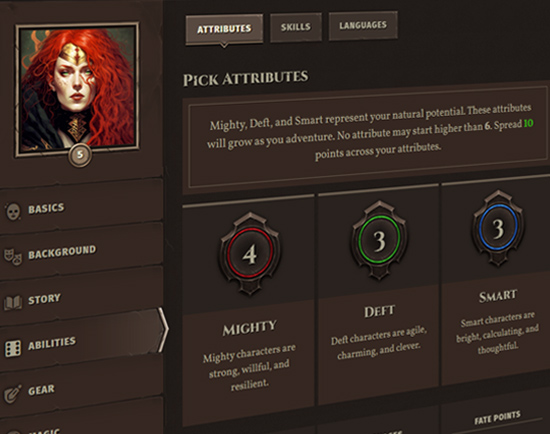The Conversation
At the heart of the roleplaying game is the unique way in which it is conducted by its players. Just as board games are characterized as players moving pieces around a board, and card games are characterized as players handling cards, roleplaying games are characterized as players having a structured conversation:
You probably know this already: roleplaying is a conversation. You and the other players go back and forth, talking about these fictional characters in their fictional circumstances doing whatever it is that they do. Like any conversation, you take turns, but it’s not like taking turns, right? Sometimes you talk over each other, interrupt, build on each others’ ideas, monopolize. All fine… All these rules do is mediate the conversation. They kick in when someone says some particular things, and they impose constraints on what everyone should say after. Makes sense, right?
Vincent Baker, Apocalypse World
How exactly that conversation is structured varies from system to system, but generally there is a single player who serves as the game's mediator (like the banker in Monopoly, but less dour), and at least two other players. These other players who are not the mediator each adopt the role of a single character in the fiction (though in some games, they may have more than one role), whereas the mediator, which we shall the game master (GM), adopts the roles of everyone and everything else in the fiction. He has a variety of responsibilities, but chief among them is to resolve what happens in the game when players take action as their characters.
Let's dissect an example of the resolution mechanic. I'm currently on a Tiger King kick, so we’ll run with a scenario inspired by that show.
Let’s break down this Tiger King “conversation.” The first thing that happens is the player Sandra declares what action her character, Tiger Keeper Lonnie, intends to take:
I want to sneak into the Tiger King’s trailer and look for clues.
The player’s intent contains both narrow and broad action: she wants Lonnie to sneak into the trailer (narrow), and then look for clues (broad). The GM intends to resolve the narrow action first, and by doing so is implicitly ruling that it is possible for Lonnie to sneak into the trailer. He begins by introducing obstacles into the fiction, and asks the player how Lonnie reacts to these obstacles.
There’s a shitty fence surrounding the trailer with a rusty lock on the gate. The trailer is about ten meters ahead, beyond the gate. You don’t see any lights on inside because Joe Exotic forgot to pay the power bill. How do you sneak inside?
We then have a back-and-forth between Sandra and her fellow player Mark, whose character is Billy the Zookeeper. They address each other in character to further immerse themselves in the fiction. Sandra then narrows the action Lonnie takes:
I clip the lock on the fence with my gardening shears and step into the enclosure.
The GM rules that there is no meaningful chance of Lonnie failing to open the lock, so he allows it to happen without a dice roll. However, he’s uncertain if Sandra truly grasps the danger she is putting Lonnie into, by entering the enclosure. Therefore he gives Sandra more information about the fiction so she can confirm Lonnie’s action:
The lock breaks easily. It’s dark inside the enclosure, and you’re not sure if there are tigers around. Do you proceed?
When Sandra has Lonnie proceed, this is the moment of resolution. The GM decides there is a chance that Lonnie will awaken one of the tigers in the enclosure, so he selects a mechanic—a “Stealth check,” which models Lonnie’s control over her own reflexes in the fiction, to determine if there’s a chance of meaningful failure. “Meaningful” here is defined as two-parts narrative and one-part simulation: it would be interesting for the roleplay if Lonnie fails and awakens a tiger, and it’s also simply a fact that Lonnie stands a chance of realistically fumbling in her movements.
Okay here we go. (She rolls a d6, but critically fails.) “Oh shit.”
At this point, the mechanic indicates that there is meaningful failure, and now it’s up to the GM to narrate the resolution. (Lonnie is attacked by the tiger, or perhaps a spotlight turns on and we learn that Joe Exotic has indeed paid the power bill…)
We can thus summarize the “conversation” as consisting of five distinct exchanges between the player and the GM:
- Player Intent
- GM Confirmation
- Mechanic Selection
- Mechanic Execution
- GM Resolution
The structure of play continues as the conversation alternates between players who declare their intent, and the GM who resolves it through the fiction. Generally roleplaying games repeat the resolution mechanic for three to six hours, or until the GM and the players agree they have reached a mutually satisfying stopping point (or they have run out of snacks).
 Archetypes
Archetypes Armor
Armor Classes
Classes Conflicts
Conflicts Cultures
Cultures Ethos
Ethos Flaws
Flaws Glossary
Glossary Kits
Kits Maleficence
Maleficence Origins
Origins Shields
Shields Skills
Skills Spells
Spells Stances
Stances Status Effects
Status Effects Tactics
Tactics Talents
Talents Techniques
Techniques Treasure
Treasure Weapons
Weapons











 Hall of Heroes
Hall of Heroes Hall of Legends
Hall of Legends



 Dungeons & Flagons
Dungeons & Flagons